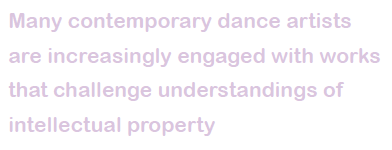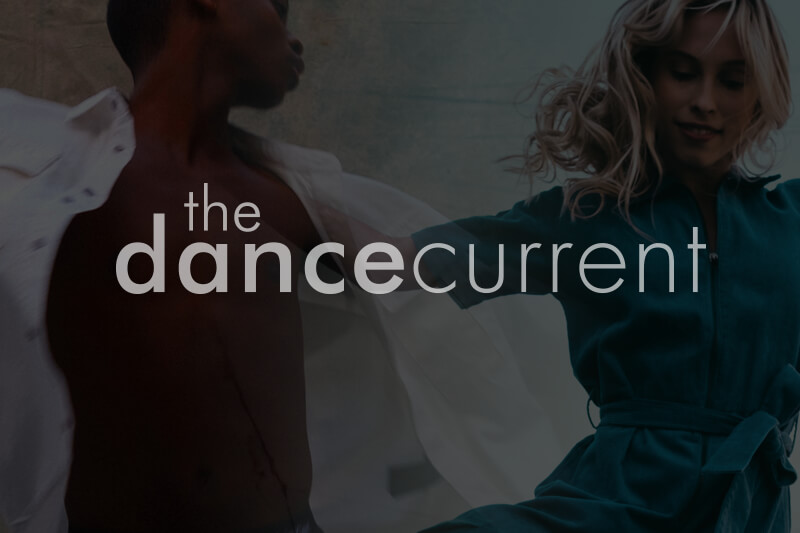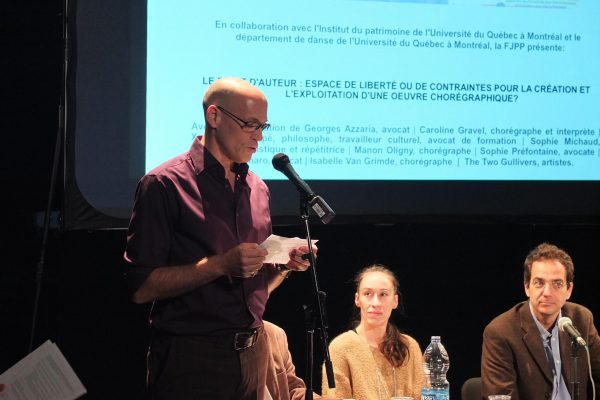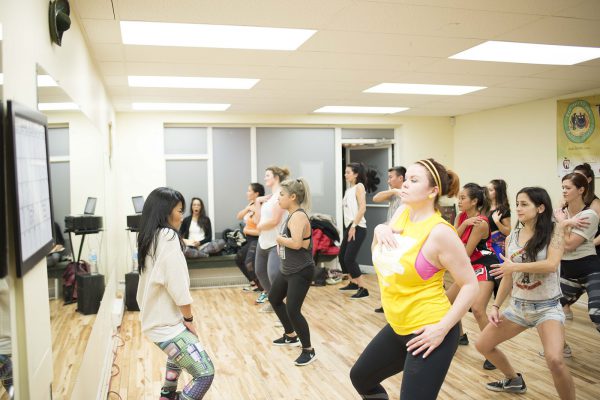In 2013, seven students in York University’s department of dance decided to form a dance collective. As with so many emerging artists, they were preparing to forge their way in the dance world without the safety net provided by their training institution. They were drawn together by friendship and a shared desire to help each other establish careers in dance. “We thought to ourselves,” recalls Denise Solleza, a founding member, “What can we do together so that we can be seen?”
Through informal discussions, they arrived at a name, Half Second Echo – a chance phrase that came to them while in the studio – and a structure for their group projects: one member would take the lead on each work and assume the title of choreographer; the others would work as collaborators and interpreters. This system allowed them to gain experience through the collective’s work while also adding to their individual resumés. They would each be responsible for their own note-taking during the creation and rehearsal processes, but video recordings would be communal and available in full to all the members. They created a website, a Facebook page and a Vimeo account and began mounting their own productions.
In time, the group found new projects through informal networking and word of mouth. They engaged in contractual agreements with choreographers outside their group, for works created for them, as members in larger casts and in a longer-term recurring agreement with Body Brake, a late-night art party curated by Anandam Dancetheatre.
Even for an emerging collective, such as Half Second Echo, issues of authorship, ownership and intellectual property are integral to their creative work as artists. They have to negotiate among themselves, engage in contracts with others and consider the value and importance of their own artistic voices and how their values can coincide and be supported by the work of the group and its work with others.
As dance artists coalesce into and drift out of projects and performances, they continually encounter ideas of authorship and ownership. I spoke with several contemporary dance artists about their understandings of ownership, authorship and the role of intellectual property in their artmaking processes. Changing ideas about the role of collaboration in dance creation and the evolving relationship between artists and digital media sharing have shaped how these concepts are understood. As dance livelihoods become more precarious, respect for dancers as artists requires a continued exploration of the meaning of authoring and owning creative work.
Dance has a long and tenuous relationship with ideas of intellectual ownership. In Canada, since 1988, “choreographic work,” defined unhelpfully as “any work of choreography, whether or not it has any storyline,” has been protected as a subcategory of “dramatic works.” For protection to be afforded, the work must be deemed original and must be fixed in tangible form (such as dance notation or, more commonly, video). Similar requirements exist in American law, though Canadian artists, unlike their American counterparts, can claim moral rights in respect to their work. These rights include the right to be associated with the work and to prevent any distortion or modification. (Fun fact: one of the Supreme Court cases that asserted these rights centred on the objections of Canadian artist Michael Snow, creator of the Canada geese sculpture in Toronto’s Eaton Centre, to the owners putting Santa hats on the work.) To further complicate matters, in the process of fixing dance through video, the performers gain separate “performers’ rights” to the recording of their performance. They are allowed certain economic and artistic rights to the use of the images or recording.
Unlike other art forms, such as music, literature or the visual arts, dance has rarely been part of legal proceedings. While there have been a few high-profile cases in the United States (notably when the estate of Martha Graham sued her school after her death), only one case about ownership of dance has ever come before the courts in Canada.
This lack of precedent is the result of the high cost of legal representation compared with the generally small income made by most dance productions but also, and more informatively, the incompatibility of choreographic artistic processes with legal understandings of originality, creativity and property. For Carys Craig, a scholar of intellectual property at Osgoode Law School in Toronto, choreography defies the attempts by the legal system to contain and commodify creativity and expressive works.

Among the many ways she sees choreography as posing instructive tensions to ideas of intellectual property, Craig argues that the legal system imposes binaries, such as choreographer/performer or work/performance, on creative work that do not speak to how dance is created, performed and shared. “Choreography combines in one expressive form,” she says, “perhaps all the features of human creativity make it so hard to confine and control through copyright’s proprietary structures.”
Anthea Kraut, an American historian and scholar of choreographic copyright, has examined how ideas about property and the inherent whiteness of the legal system have actively favoured the recognition of certain forms of artistic impression by certain types of people. White male individual artists, with greater means to control the media of their artistic expression, and working in artistic lineages in line with the European tradition of the American legal system, were more likely to have their worked deemed protectable.
Even if legal means are ineffective, inappropriate or unattainable for most dancers and their works, there are still cultures of ownership and ideas of authorship that structure how dance is created, participated in and shared. One of Kraut’s main arguments is that while dance can and has been understood as functioning through a gift economy, where value is placed on sharing, it also exists in the economic systems that dominate Canada and the United States. There is an economic value to those exchanges.
Many dancers have sought and continue to seek to conserve the value of their work through extralegal methods. Signature moves, styles and routines, for example, have long allowed some artists to use their personal style and skill to popularize movements that were hard to replicate. In the 1930s, Bill “Bojangles” Robinson created a tap routine on a staircase, iconically performed on film with Shirley Temple in The Little Colonel (1935). It was technically difficult and the style, choreography and use of props made it easily recognizable. Such signatures were policed by the dance community itself, according to Kraut, by applying personal and economic pressure to individuals who sought to appropriate works in ways deemed inappropriate.
Both the legal and extralegal means of protection of intellectual property see elements of authorship in dance that should and can be protected. From a legal perspective, the protection of the intellectual property safeguards that which is unique and original in a work, which is therefore understood to have economic and artistic value. The original purpose of these protections was to encourage artistic endeavour by allowing creators to benefit economically from their work, thereby, in theory, encouraging more and greater artistic work. Whether or not this policy has its intended effect is still a point of debate. But what further complicates the discussion for contemporary dance is that current understandings of authorship are far less clear-cut and less individualistic than the legal system acknowledges.
“Authorship,” says Vancouver-based contemporary dance artist Justine A. Chambers, “is what you need as a choreographer, personally and professionally. It’s about personal values, how the work is held in public.” For the artists with whom I spoke, this value most frequently lies in the creative process, not its product. According to Solleza, as a choreographer, she sees her creative role as one of shaping and moulding, instead of creating or assigning. “It’s about facilitation, creative direction,” she explains. When she creates a work, either for Half Second Echo or on independent projects, she sets tasks, games or exercises for the dancers to explore preconceived ideas or themes. Authorship lies, for her, in defining “the structure in which creative activity happens.”
For Chambers, that value lies in the exploration of the complexity of the individual experience. Her Family Dinner, for example, is a dining performance through which the artists have created a lexicon of movements, drawing from the movements of participants in each iteration of the work. Chambers points to a long history of dinner as performance; there is no originality in that aspect of her work. Instead, she says, it is in the specific experience of the work, which is itself the result of her interests and lived experiences, along with the ideas and experiences of her collaborators.
For mid-career and established choreographers, this process-oriented artistry was developed over time. Tracey Norman, an independent dance artist based in Toronto, explains that earlier in her career, she felt a need to arrive in the studio with preconceived movements that she would set on the dancers. But as her confidence has grown, and as her artistic process has developed, she has become more inspired and interested in the collaborative studio process. “I want to walk into the room knowing enough to lead the process,” she says, “but not knowing too much because then what’s the point of collaborating. The longer I do it the more transparent I want to be.”
For William Yong, artistic director of Zata Omm, a contemporary dance company based in Toronto, the creative process also extends beyond the studio. His works, as with most artists, are the result of years of research, development and collaboration. Further, they are the product of the support of his dance company, his funding and the efforts to produce and present the piece. That labour, for him, is part of the authorship.
As that authorial voice is shared, most artists interviewed expressed only mild concern about illegal copying or reproduction of their work. This seemed unlikely or irrelevant. They were, however, interested in maintaining some control over the experience of the work. This was particularly true of sharing work digitally. None of the artists I spoke with post full video recordings of their work online. An increasing number of artists, including Chambers, no longer use video as part of their process. These decisions stem from a desire not so much to prevent illegal copies or reproductions but to acknowledge the failure of filmed media to represent the lived experience of a work.
Christopher House, artistic director of Toronto Dance Theatre, now uses almost no video in his work.“The constant presence of digital technology in our lives has made me dive deeper in the liveness of the work,” he says. “That’s where the real pleasure is for me, and the essence of the thing.”
Further, the live work is not a static product that can be reproduced but a living, changing experience. House says he is interested in how a work evolves as the artists perform the work. “The first performance is just the beginning of the thing,” he says. “For me, it is through watching the performances that the truth of the work starts to emerge, and its potential. Then the exciting work happens.”
While copyright can in some instances provide protection against unwanted reproductions, what was more important morally for dance artists was publically recognizing the work and contribution of collaborators. “We know as artists that especially in the independent dance sector, there is not a lot of money,” says Solleza. “Sometimes having your name mentioned can be the biggest payment or acknowledgement; it can be the most important thing.” The language through which contributions are acknowledged is important. While mentioning how credits so frequently fail to address the complicated and evolving contributions of individuals to a work, House says he draws his example from the artists around him. “It’s an ongoing conversation,” he says. “You look and see how other people in the field are acknowledging what has happened; it’s a work in progress as every work follows a somewhat different process. You do the best you can with the information you have, trying to do the right thing. You make mistakes. You learn.”
Conversations with collaborators about the process are important. Earlier this year, Half Second Echo collaborated with Norman to create HOW TO TEAR DOWN A WALL, choreographed by Norman. As part of the process, before signing a contract, Norman invited the members of the group, Justine Comfort, Miles Gosse and Solleza, to discuss its contents together, including the responsibilities, rights and commitments it laid out. The conversation was ongoing and Solleza appreciated the time Norman gave the performers to consider the agreement and to return with questions or comments. To a similar end, Chambers asks herself, “How can I make the people I work with not feel powerless to address these issues with me?”
For both Norman and Chambers, it is important to recognize the collaboration of artists in the manifold ways artists discuss their work around performances: interviews, talkbacks, promotional materials, funding applications and announcements. For Norman, in the daily interactions and work of choreographers and performers, crediting the collaborative process has become more acknowledged and run-of-the-mill. “But there are still issues of crediting in advance,” says Norman. The choreographer and composer are usually mentioned in announcements for upcoming works, but even in cases where the performers are already known, they are rarely included. Chambers echoes this concern with public acknowledgement of that collaboration. “Part of the agreement I have with myself, out of respect for the people I work with,” she says, “is that I always speak about them in those public instances. I want to define for the public that I did not make this work alone, though I may have had the final say.”
Artists from different disciplines approach intellectual property with different concerns and expectations. Formal contracts tend to be more common in other fields, with clearer articulations of ownership and intellectual rights. Many dance artists welcome the straightforwardness and transparency of such expectations.
Through his professional interest in the possibilities of movement and technology, Yong has frequently collaborated with individuals from a variety of disciplines. In 2017, he presented Steer, created with visual artist Jérôme Delapierre and composer and sound designer Navid Navab, in which sensory data from the dancer, gathered through motion capture and sensors, produce instantaneous sound and lighting effects. As with some of his other works, most of the devices used in Steer – the sensors and projects – were easily accessible or open source. “But it’s the way we write the application,” Yong says, “that is the technology artists’ rights. It’s much more personal, and we have much clearer intellectual property and credit.”
In creating works that involve patent, copyright and trademark law, particularly around technology, Yong counsels dance artists to inform themselves about applicable laws and ensure they have the necessary protections. “Many people don’t bother,” he says, “because they see their work as being about the style or the aesthetics, not the actual products in use. And I’m less guarded than many, particularly those outside of dance, but I’m starting to look more carefully at these issues.”
This trepidation is not without reason. There are violations of the moral code of artistic intellectual property, if not the legal code, among dancers. The interviewees shared stories of both gratuitous copying – works remounted without permission in different locations – and more borderline borrowings – ideas presented during informal showings that then appeared in another artist’s work. Most artists I spoke with said they had never been the victims of any egregious stealing, but several mentioned having been part of collaborations that subsequently did not recognize their contributions in the ways they had expected during the process.
“It is about the power paradigm,” says Chambers. The more established artists could find ways to delineate the premises of their collaborative work: who they worked with, how they engaged with others, how contributions would be acknowledged. When they had been emerging artists, they had less control. They were less likely to be able to dictate the terms of a collaboration, less likely to be able to speak up about their stake in future performances. Sour experiences had shaped artistic processes in the present, as the artists often tried to ensure a respect for their present artistic collaborators.
Ever a possible remedy to abuse of power, gossip remains one of the tools available to those without direct access to legal remedies. “Gossip is an underrated tool for dancers,” says Chambers. Speaking out about creative and intellectual abuses is, for her, part of the unsilencing of dancers. According to Kraut, the historian of choreographic copyright, such informal policing has long been part of a disenfranchised artistic world’s attempts to negotiate their property. “Tell each other the great and the terrible,” says Chambers. In this way, dancers share information and force unequal power relations to engage with them as talking, thinking bodies.
According to Craig, those outside of the community also pose an important risk to dancers’ intellectual property. “The law,” she says, “floats above the art form as a kind of threat that could be leveraged by outside parties.” While the social norms and moral codes might have teeth among dancers, the law can be used by corporate owners, for example, who do not know or do not operate according to those conventions, to assert ownership and obtain income. An accurate and informed understanding of what contracts can and cannot demand, what they can and cannot protect is an important starting point.

Better and more consistent pay is important for the health of the dance community, but if the underlying goal is respect for artists, that must also extend to their creative input and participation. In many ways, contemporary dance artists do try to acknowledge both the collaborative nature of their work and the different levels of responsibility and involvement in their processes and presentations. Much of this work is helping decouple contemporary concert dance from the hierarchical and problematic training and ideological system whence it came. Transparency and openness to discussion are important tools in countering this past, helping to foster respectful artistic and economic relationships.
Many contemporary dance artists are increasingly engaged with works that challenge understandings of intellectual property. In this digital age, many artists are ever more interested and concerned with the live experience of dance performance. Additionally, it is the process of artistic creation, not its final product, which is often deemed of creative value. In both of these ways, dance poses a continuing challenge to legal understandings of creativity as replicable, fixable and tangible. Dance can only exist in the cultural and social worlds from which it emerges, but it promises to continue to help draw attention to the limits of those worlds. Creating and sharing creative experiences remains important. “A feeling of authorship is significant,” says Solleza, “but I care much more about the works I create being out there, in the world.”
Tagged: Contemporary, copyright, Copyright for Choreographers, All , Canada





